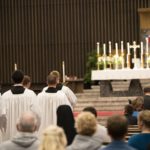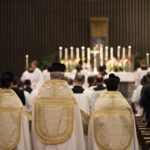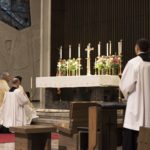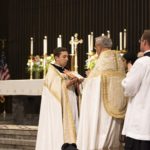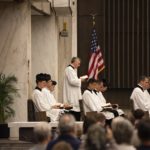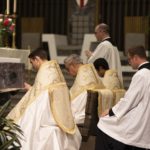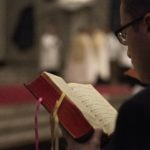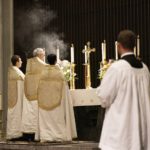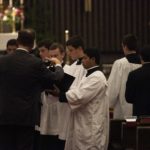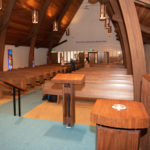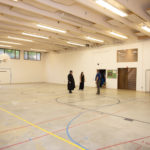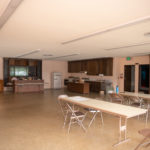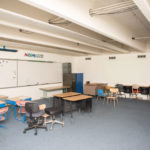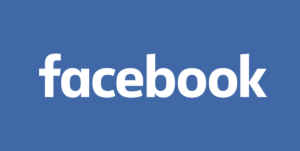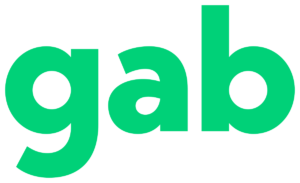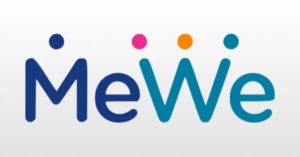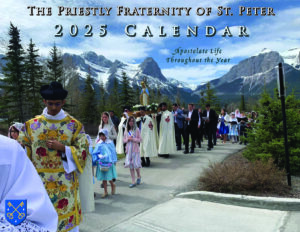OLGS Sings Solemn Vespers at Lincoln Cathedral
 This past Sunday, the priests and seminarians of Our Lady of Guadalupe Seminary sang the Solemn Vespers of St. Michael the Archangel at the Cathedral of the Risen Christ in Lincoln, NE. Fr. Justin Wylie, the rector of the Cathedral, invited the Seminary to sing Vespers to begin the 40 Hours Devotion which the Cathedral held from September 29th through October 1st to commemorate their 60th year of Perpetual Adoration. 60 years of continual Adoration – what an extraordinary gift to God and a wonderful opportunity to celebrate with our friends at the Cathedral! +
This past Sunday, the priests and seminarians of Our Lady of Guadalupe Seminary sang the Solemn Vespers of St. Michael the Archangel at the Cathedral of the Risen Christ in Lincoln, NE. Fr. Justin Wylie, the rector of the Cathedral, invited the Seminary to sing Vespers to begin the 40 Hours Devotion which the Cathedral held from September 29th through October 1st to commemorate their 60th year of Perpetual Adoration. 60 years of continual Adoration – what an extraordinary gift to God and a wonderful opportunity to celebrate with our friends at the Cathedral! +
October 5, 2019
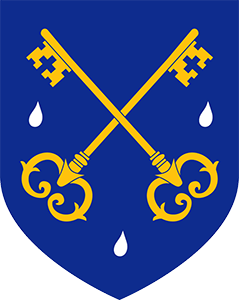
Angels in 5 Minutes

Happy feast of the Guardian Angels! In celebration of today’s feast, of St. Michael’s last Sunday and of St. Raphael’s which will arrive in 22 days, we challenged ourselves to create a bullet-pointed, handout-worthy, Facebookable version of two articles on angels by Dr. David Arias, professor of philosophy at Our Lady of Guadalupe Seminary. The consecutive articles, The Angelic Nature and The Understanding and Action of Angels, appeared in the September and October 2017 editions of Meménto, and gave a fascinating overview of who and what angels are, how their vastly superior minds work and what their role is in our own lives. Since you’re not a Catholic if you’re not an amateur (or professional) angelologist, we shall presume your interest in the subject matter. Here we go.
The Angelic Nature
- An angel is a created substance that is incorporeal and intellectual (St. Thomas Aquinas).
- Angels are persons, since everything with an intellect and a will is a person (Boethius).
- Although we’re both made in the image of God, angels differ from us insomuch as they are wholly incorporeal. Our souls are incorporeal, but the proper function of a soul is to inform a body, and hence it is not a complete substance without its body.
- Because they are immaterial, angels are naturally incorruptible.
- In addition, because, unlike us, they have no material as part of their nature (our bodies are created of material that can also be found in dogs, rivers, stars and other humans), they are irrepeatable. They are one-of-a-kind, possessing their nature so totally and completely as to exclude the possibility of another angel being of the same “species.” Each one is essentially unique.
The Angelic Mind
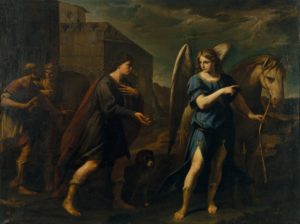
- Unlike us, angels have intrinsic and instantaneous knowledge of things. In order to form concepts of things, we have to first experience those things in our senses, then we can begin to understand their nature by considering what they have in common. Angels do not utilize this abstractive mode of thinking; they are infused with all the knowledge they need, and their knowledge of creatures includes knowledge both of a thing’s nature and of the particular examples of that nature. E.g., an angel with the knowledge of dogs understands the nature of a dog and Fido, Rex and Rover insomuch as they are possessors of the canine nature.
- Angels don’t reason. We humans move from a known concept to an unknown one using our reason, but angels’ knowledge is complete. An angel with the knowledge of triangles need not deduce that the sum of the angles of a triangle is always 180 degrees; he already knows everything there is to know about a triangle (if only, say the Euclidean geometry students).
- The angels bear a more perfect image of God than we do, due to their superior and more God-like intellect. Sorry, humans.
The Angels in Action

- Angels often put their angelic understanding of created things to work when they act in the natural world, as we see them do regularly in Scripture.
- Angels are teachers to us humans, and they do this in two ways, according to St. Thomas:
- They act on our interior sense powers (such as our imagination) to help us form mental images that help us to better understand things than we would on our own. They can also help us recall things that we already have in our intellect more easily (another tip for the geometry students).
- They unite their own intellectual understanding to ours to strengthen our intellect and help us perceive concepts better and more clearly. An analogy might be a pot of hot water (our intellect) that can heat pasta, but will do it an awful lot better with a fire underneath it (the angelic intellect).
And there you have it, angels in five minutes! Of course, there is much more to know about angels than we have room to discuss here, more, in fact, than we will have time to think about in this life, but fear not. The angels, and our Guardian Angels in particular, are fully invested in our salvation, and if we avail ourselves of their assistance and friendship, we can continue the conversation in Heaven. +
Angel of God, my guardian dear, to whom God’s love commits me here, ever this day be at my side, to light and guard, to rule and guide. Amen.
October 2, 2019

And You Visited Me
Where do you go next after running with the Saints? The City of Angels, of course. St. Vitus Parish, our apostolate in Los Angeles, was our destination after we took a reluctant leave of San Diego and headed north during the Missive’s 2019 California expedition, a tour of three apostolates that began in San Diego on July 26th and ended 500 miles away in Sacramento on August 5th. L.A. was our second stop.
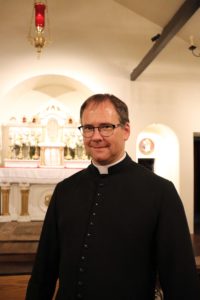
FSSP Los Angeles was founded in 2014 and is the fruit of several years of attempts to found an apostolate that had been stymied by the lack of an available Catholic church. In 2014, the FSSP asked if they could come and try to find an empty Protestant church to convert to the purpose, and Archbishop José Gomez granted permission. Fr. Fryar arrived and worked out of several temporary locations, primarily St. Victor’s in West Hollywood, before they at last found their own church in San Fernando in north Los Angeles. Archbishop Gomez dedicated the church of St. Vitus in June of last year and raised it to the rank of a parish.
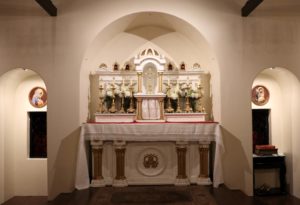
The only problem – if you can term it a problem – is that the parish has already outgrown the space, with indicators that the congregation would grow even more if they had more room. The church is full to overflowing four times a Sunday, with a total count of 400-450 (the church seats 120) after the priests saw the numbers double with the addition of the fourth Mass. For Holy Week this year, the parish set up a 500-person tent outside, with 400 people attending the Easter Vigil and around 700 over the week. But this is not an uncommon problem among Fraternity apostolates, and St. Vitus is approaching the issue as any other apostolate would: by raising money and getting a bigger church, hopefully by building one. They intend to stay in San Fernando, as it has proven to be a good part of the city for a number of reasons, among which is that it is amenable to most parishioners in terms of the infamous L.A. traffic (which is not to be trifled with; it can add 60+ minutes onto a trip during rush hour).
The music program at St. Vitus is particularly strong. The two choirs (one for each Sunday High Mass) are run by director Jeff Ostrowski, who had previously collaborated with the Fraternity to produce the St. Edmund Campion Missal & Hymnal, a common sight in Fraternity pews. The parish also hosts the annual Sacred Music Symposium, a week of training for choir directors and singers that takes place in June and features instruction from world-class musicians.
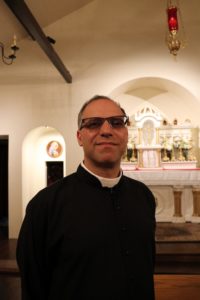
But perhaps the most thought-provoking ministry of our L.A. apostolate is its prison ministry, which, if most of us have perhaps heard the term, is not something we necessarily come into contact with on a daily basis. Fr. Federico Masutti, who is in his third year as assistant pastor, is priest-in-charge of the operation, which takes place at a large L.A. County state prison. He travels there regularly, primarily to offer the Sacrament of Confession to the inmates, and he has also celebrated the traditional Mass there several times. The ministry began when an inmate who had heard about the traditional Mass requested that a priest come to see him. Fr. Masutti considered it a good opportunity to assist with the needs of the Archdiocese; he said that it’s always good for the priests of the Fraternity to show that they can help with the priestly duties – such as hospital calls and chaplaincies – in the different dioceses where they are located.
There is a large Catholic population at the 5,000 person prison, said Fr. Masutti, but many are fallen away. He explained that a great need for prison ministry exists across the United States, as there is a scarcity of priests and the logistics are often difficult due to the remote location of most prisons. He considers it important to maintain a Catholic presence in the prisons, as many of the Catholics don’t have the opportunity to receive guidance and instruction in the Faith and there is a danger of them losing the Faith. But he says that there is much that can be done despite the difficulties, and even the parishioners at St. Vitus have lent their assistance by making rosaries and donating Catholic books for the prisoners.
Of course, a stereotype often comes to mind when we think of prisons, the images evoked involving, perhaps, maximum security facilities, dark halls, gangs, etc. But Fr. Masutti explained how his experiences at the L.A. prison dispelled those ideas, to the point that sometimes it’s easy to forget that you are in a prison facility. He recounted a memorable experience that occurred early on in his ministry. As he was preparing to hear Confessions in a classroom at the prison, one of the inmates simply smiled and said, “Good morning, Father.”
“From that moment on, everything changed in me,” said Fr. Masutti. “Everything disappeared when I saw that human element.”
Furthermore, he finds it moving to see how much the inmates desire to receive the Sacrament of Confession, and how happy they are to see a priest.
“It’s very rewarding spiritually,” he said.
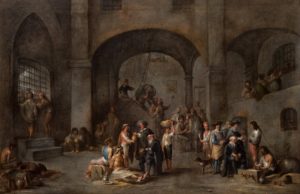
Fr. Masutti also addressed a question that probably arises in the minds of many of us when we consider how many young people end up in prison: Why are they here? These are people who are young and healthy. They are capable of working and have obvious talents: some take art classes at the prison and produce beautiful drawings. In a word, they have all kinds of potential, but instead of building successful lives for themselves, they somehow chose to go down a path that landed them in prison. Why? Fr. Masutti notes that many of them come from broken families.
“And that’s why family life is key,” said Fr. Masutti. “A government should protect the institution of the family, because most of those people there, I would say a very high percentage, they don’t have families . . . they are all broken families.”
He says that another problematic element of prison life is that, for the most part, these prisoners don’t get any visits, abandoned by those who know them on account of their crimes.
“They don’t get anything,” Fr. Masutti said with emphasis. “Because of the crimes that they committed before, a lot of people don’t [want to have] anything to do with them. But then it’s easy to forget. You don’t want to go to that environment, you don’t want to be there.”
He continued by quoting Matthew 25, where Our Lord speaks of the corporal works of mercy, among them, visiting the imprisoned. In that passage, Our Lord identifies Himself with the suffering and the imprisoned, saying that, when we visit them, we visit Him.
“All of us,” Fr. Masutti explained, “in one way or another, according to the circumstances that we have in life, we need to live those corporal works of mercy. Because those are the things in which Our Lord is going to judge us at the Last Day.”
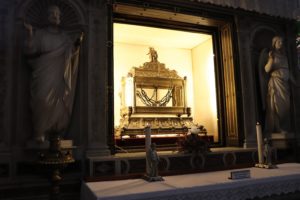
Fr. Masutti mentioned that many saints, and even Our Lord Himself, were in prison. We were speaking to Fr. Masutti on August 1st; our final challenge to you is to go grab a pre-1960 missal and look up the old feast for that day. +
Then the righteous will answer Him, ‘Lord . . . when did we see thee sick or in prison and visit thee?’ And the King will answer them, ‘Truly, I say to you, as you did it to one of the least of these my brethren, you did it to me.’
– Matthew 25:37, 39-40
September 30, 2019

Happy Feast of the Dedication of St. Michael the Archangel!
A happy and most blessed feast of the great Archangel St. Michael! Today’s feast is of the first class; it therefore bumps the sixteenth Sunday after Pentecost to the commemoration spot, so important is St. Michael’s feast deemed by Holy Mother Church.
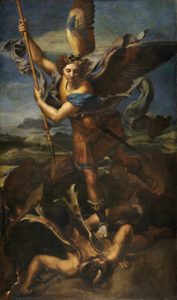
St. Michael is known to us as the prince of the angels and leader of the heavenly armies, and as such he is the great nemesis of Satan. The latter said, “I will not serve” and aspired to defeat God Himself; the very name of St. Michael, by contrast, means “Who is like God?” and he led the good angels in battle against Satan and the fallen angels, casting them out of Heaven forever. He is mentioned by name both in Sacred Scripture (the book of Daniel, the letter of Jude and Revelation) and in the Sacred Liturgy as well. Nearly always portrayed in battle array with a sword or spear in his hand and Satan under his feet, St. Michael is the stalwart defender of Christians against the attacks of the Devil and our constant help in our spiritual battles. He is invoked in the well-known prayer to St. Michael, which we say with the other Leonine prayers after Low Mass and which should be in our hearts frequently besides. Let us not take our angelic friends for granted, but rather let us call upon them always, especially St. Michael, his fellow Archangels and our Guardian Angels, whose feast we celebrate on Wednesday.
The cover photo shows the cavernous Sanctuary of St. Michael at Monte Sant’Angelo, Italy, a place famous for the apparitions of St. Michael that occurred there. The church, set in the recesses of a cave, was never consecrated by human hands, since the Archangel himself consecrated it by his presence.
We wish a happy patronal feast day to St. Michael the Archangel Parish, our apostolate in Scranton, Pennsylvania! They are celebrating with a Solemn High Mass and pancakes today! +
Deus, qui miro órdine, Angelórum ministéria hominúmque dispénsas: concéde propítius; ut, a quibus tibi ministrántibus in cœlo semper assístitur, ab his in terra vita nostra muniátur.
O God, Who hast constituted the services of Angels and of men in a wonderful order, mercifully grant, that they who ever stand before Thy face to do Thee service in Heaven, may also defend our life upon earth.
– the Collect for today
The Prayer to St. Michael
St. Michael the Archangel, defend us in battle, be our protection against the wickedness and snares of the Devil. May God rebuke him, we humbly pray, and do thou, O prince of the heavenly host, by the power of God, cast into Hell Satan and all the evil spirits that prowl about the world seeking the ruin of souls. Amen.
September 29, 2019

FSSP Guadalajara Hosts 2nd Annual Homeschool Conference
by Guetty Pérez Colín
From July 5th – 7th, 2019, the 2nd annual “Pillars of Education” Catholic Homeschool Conference was held in Guadalajara, Mexico. The event was organized by Sedes Sapientiae, the homeschool cooperative of the parish of San Pedro en Cadenas of the FSSP in Guadalajara. This year, the title of the event was “Classical Education and Catholic Tradition.”
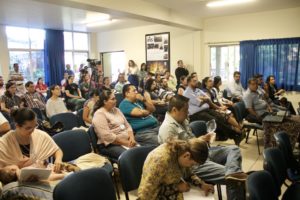 In total 166 people, 88 adults and 78 children, participated in the event from 10 different cities across Mexico. It was very inspiring to see so many large families gathered because of their commitment to give the best possible Catholic education to their children.
In total 166 people, 88 adults and 78 children, participated in the event from 10 different cities across Mexico. It was very inspiring to see so many large families gathered because of their commitment to give the best possible Catholic education to their children.
Unlike last year when the talks were directed primarily to those who already educate their children at home, this year the conference took a slightly different approach. Recognizing that parents must always be the primary educators of their children (whether they attend school or are educated at home), the organizers wanted to create an event of interest to all Catholic families. Therefore, this year’s conference sought to expound upon the rudiments of classical educational philosophy.
 The classical method has been used for centuries, from the days of ancient Greek thinkers, through great saints such as Saint Thomas Aquinas, to the present day. The methodology helps teach the child to express, think, analyze and, finally, to communicate their ideas with well-developed arguments. It seeks to form human beings who do not just go with the flow, but rather who love and seek truth and beauty. And where there is real truth and beauty, there one always finds God.
The classical method has been used for centuries, from the days of ancient Greek thinkers, through great saints such as Saint Thomas Aquinas, to the present day. The methodology helps teach the child to express, think, analyze and, finally, to communicate their ideas with well-developed arguments. It seeks to form human beings who do not just go with the flow, but rather who love and seek truth and beauty. And where there is real truth and beauty, there one always finds God.
 The event also made clear that Catholic tradition goes hand in hand with classical education. Both seek to instill reverence and an appreciation for truth and beauty. Both also have a long and proven track record. Knowing and living the tradition of the Church helps us to yearn for our own holiness and that of our children. Many participants in the conference experienced the traditional liturgy for the first time during these three days.
The event also made clear that Catholic tradition goes hand in hand with classical education. Both seek to instill reverence and an appreciation for truth and beauty. Both also have a long and proven track record. Knowing and living the tradition of the Church helps us to yearn for our own holiness and that of our children. Many participants in the conference experienced the traditional liturgy for the first time during these three days.
Some of this year’s conferences given by the priests and other guest presenters included:
“The Richness of Liturgical Tradition”
“What is a True Teacher?”
“The Essential Role of Art in the Formation of a Christian”
“The Trivium”
“Anthropology of Classical Education”
“How to Live According to a Rule of Life”
…among others.
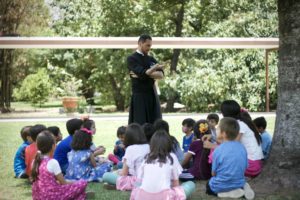 For the children there were also activities and themes during the event. There was an opportunity for them to receive formation, and also make new friends and play among themselves. Something very valuable for many families was the participation of the seminarians who were in Guadalajara participating in the Saint Junipero Serra Summer Spanish Institute. How important it is for the young to see their example! We hope some might be inspired to ask themselves if they too might have a vocation to give their lives to Christ for the salvation of souls.
For the children there were also activities and themes during the event. There was an opportunity for them to receive formation, and also make new friends and play among themselves. Something very valuable for many families was the participation of the seminarians who were in Guadalajara participating in the Saint Junipero Serra Summer Spanish Institute. How important it is for the young to see their example! We hope some might be inspired to ask themselves if they too might have a vocation to give their lives to Christ for the salvation of souls.
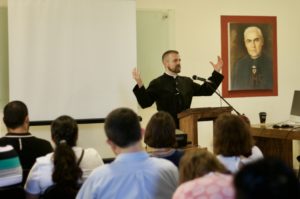 This year also included a day-long family retreat prior to the beginning of the conference, especially for those who came from outside the metropolitan area and do not have access to the Holy Mass in the traditional form. The families heard talks from Father Daniel Heenan, FSSP, pastor of the parish in Guadalajara. The theme was “Jesus, Eternal Wisdom.” There was time for meditation, prayer, confession and of course the Holy Mass.
This year also included a day-long family retreat prior to the beginning of the conference, especially for those who came from outside the metropolitan area and do not have access to the Holy Mass in the traditional form. The families heard talks from Father Daniel Heenan, FSSP, pastor of the parish in Guadalajara. The theme was “Jesus, Eternal Wisdom.” There was time for meditation, prayer, confession and of course the Holy Mass.
 Next year the conference will run from August 2nd – 9th. The duration is being extended to one week since, in the first two years, the meeting has proven useful for families who educate at home, but also to promote the traditional Holy Mass, which is still very little known across Mexico and Latin America. The event will include a Gregorian chant and sacred art workshop, a pilgrimage for young adults, a theological colloquium and a day of recollection. Thanks be to God, families from Guadalajara have become members of the parish as a result of the conference and many who live elsewhere have gone home determined to work to bring the Latin Mass to their cities.
Next year the conference will run from August 2nd – 9th. The duration is being extended to one week since, in the first two years, the meeting has proven useful for families who educate at home, but also to promote the traditional Holy Mass, which is still very little known across Mexico and Latin America. The event will include a Gregorian chant and sacred art workshop, a pilgrimage for young adults, a theological colloquium and a day of recollection. Thanks be to God, families from Guadalajara have become members of the parish as a result of the conference and many who live elsewhere have gone home determined to work to bring the Latin Mass to their cities.
For more information about the conference and the apostolate of Sedes Sapientiae visit us on Facebook at www.facebook.com/SedesSapientiaeFSSP or write to us at sedes.fssp@gmail.com. +
September 24, 2019

Funeral Arrangements for Fr. Michael Irwin, FSSP
Please see the details below regarding the funeral arrangements for Fr. Michael Irwin, FSSP, who passed away earlier this week. All are welcome to attend.
The viewing, Rosary and funeral will be held at St. Thomas Catholic Church, located at 919 E. Indiana Ave., Coeur d’Alene, Idaho 83814.
The viewing will be from 5 – 7 p.m. on Wednesday, September 25th, with the Rosary at 7 p.m.
The funeral will be on Thursday, September 26th, at 10 a.m., with the interment to follow at Evergreen Cemetery, 2834 N. Spokane St., Post Falls, Idaho 83854.
In your charity, please continue to pray for the repose of Fr. Irwin’s soul. +
In paradísum dedúcant te Ángeli: in tuo advéntu suscípiant te Mártyres, et perdúcant te in civitátem sanctam Jerúsalem. Chorus Angelórum te suscípiat, et cum Lázaro quondam páupere ætérnam hábeas réquiem.
May the Angels lead thee into paradise: may the Martyrs receive thee at thy coming, and lead thee into the holy city of Jerusalem. May the choir of Angels receive thee, and mayest thou have eternal rest with Lazarus, who once was poor.
– the first Antiphon at the burial
September 21, 2019

September Ember Days This Week
Wednesday, Friday and Saturday of this week are the September Ember Days. Occurring once in each of the four seasons, the Ember Days are three days traditionally set aside for prayer and penance, the intention being to thank God for the gifts of Creation and to ask His help in using them well. Earlier this year, Fr. Arnaud Devillers, FSSP, wrote a fascinating piece that we published during the Lenten Ember Days about the history and significance behind this tradition, and we recommend it for your perusal again as we find ourselves already upon the Ember Days of autumn. Click here to read!
Sanábo contritiónes eórum, díligam eos spontánee: quia avérsus est furor meus ab eis. Ero quasi ros, Israël germinábit sicut lílium, et erúmpet radix ejus ut Líbani.
I will heal their breaches, I will love them freely; for My wrath is turned away from them. I will be as the dew: Israel shall spring as the lily, and his root shall shoot forth as that of Libanus.
Hosea 14:4-5, from the Epistle for Ember Friday
September 20, 2019

Requiéscat in Pace: Fr. Michael Irwin, FSSP
Please pray for the repose of the soul of Fr. Michael Irwin, FSSP, who passed away yesterday evening. Fr. Irwin had been suffering for some time from Parkinson’s Disease.
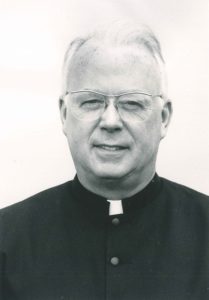
Fr. Irwin was born on November 23rd, 1937 in Hutchinson, Kansas, and moved to Dallas with his parents and two brothers in 1949. He was ordained a priest for the diocese of Dallas on May 30th, 1964 at Sacred Heart Cathedral, and was thereafter attached to the diocese of Fort Worth, created in 1969. He worked in various parishes in the region and did missionary work in Mexico before joining the Fraternity, only two years old at that point, in 1990. He first served at our seminary in Germany, where he was the spiritual director and confessor for the English and Spanish speaking seminarians.

In July 1991, Fr. Irwin became the first FSSP priest to serve in North America when he was assigned to head up the continent’s first FSSP apostolate in Dallas, Texas. He also led our apostolates in Rapid City, SD, Vienna, OH, Maple Hill, KS and Post Falls, ID.
North American Superior Fr. Michael Stinson offered a Solemn Requiem Mass for Fr. Irwin today at the chapel here at headquarters. His funeral will take place next week in Idaho, and we will post further details when they are available. +
Réquiem ætérnam dona ei, Dómine: et lux perpétua lúceat ei. Requiéscat in pace. Amen.
September 18, 2019

Ask Father: September 2019
Why is St. Augustine called the greatest of the doctors? – Jeanne from Colorado Springs
In the first part to this question, we narrowed the category of Doctor of the Church to those four principal doctors honored with that title by Boniface IV in 1298. In this second part, we shall establish the criteria on which we will determine who in fact is “the greatest.”
The title “doctor” gives the essential criteria on which we should primarily focus. According to popular usage, the title “doctor” means a medical practitioner with secondary entries in the dictionary defining the term as a person who holds a doctorate or is an eminent theologian. All these uses are derivative and miss the primary meaning of the name “doctor” which hails from the Latin doctor (teacher), the agent noun of the verb docere (to teach). The activity of “teaching” is the essential quality of a doctor, at least in its use in the title “Doctor of the Church.” It is from teaching that the title came into existence, and it is because of their teaching activity that certain Fathers were awarded the title.
The work of the original four Doctors of the Church was prodigious, yet all are a distant second to St. Augustine in scope and productivity. St. Jerome would possibly be close if one considered his translations, but even then, the totality of his work is dwarfed by St. Augustine’s. The sheer quantity of pages written have astounded Christians through the ages to the point of becoming a proverb: “He is a liar who confesses to have read the whole of Augustine’s works.”[1] St. Isidore of Seville (made a doctor in 1722) expressed this aptly: “He wrote of such a volume that it couldn’t even happen that a man working night and day could write all of his books let alone read them.”[2] His surviving works cover over one hundred individual titles from apologetics, dogmatic theology, political philosophy and Scripture commentary. Considering that what remains is only a part of his productivity (he even lost a book during his lifetime[3]) and that he wasn’t even a Christian until the age of thirty-one, he must have been a veritable genius.
To produce work is distinct from teaching. One may write copious amounts, and yet, if no one reads it, it remains “buried talent.”[4] Undoubtedly, St. Augustine produced work, but did he teach? He did, and more importantly, he has never stopped. In his own lifetime, he effectively taught against numerous heretics: Arians, Donatists, Manichaeans and Pelagians. He remains an effective antidote to these heresies, especially the latter two which have consistently plagued mankind throughout the centuries. His dogmatic works are fundamental texts often cited in magisterium documents, especially his On the Trinity, On Christian Doctrine, On Virginity and On the Good of Marriage.[5] His two most popular works, Confessions and City of God, have never been out of circulation since they were penned. For the sake of brevity, I omit his Scripture commentaries and sermons which are continually read throughout the year in the Divine Office. Beyond simply enumerating his important works, the strongest proof of St. Augustine’s continued teaching activity will be found in the most important teacher from the scholastic period—St. Thomas Aquinas.
St. Thomas is considered by many to be the greatest teacher. John XXII speaking of Thomas says, “He enlightened the church more than all the other doctors.” Many may object to my omitting of St. Thomas from the running of the greatest doctors. But I wonder how St. Thomas (“a master whose doctrine should be followed in a special way at all times”[6]) would consider my opinion? True, we cannot ask the Angelic Doctor, but we can get a reasonable indication of his opinion by consulting his texts. If St. Thomas is the greatest teacher, who taught the master? Let us consider St. Thomas’ greatest work, the Summa Theologiae, for our answer.
As stated in part one, the doctors of the sixteenth century (Sts. Thomas and Bonaventure) were a different sort of teacher than those from the patristic period. They organized and extended the accumulated teaching of the ancients. They were scholastics and their works were mainly derivative. St. Thomas never answers a single question in his Summa without quoting an authority (in the form of a Church Father, Scripture or Tradition) for support. He has no interest in standing alone as a teacher, rather he goes to great effort to demonstrate that he stands upon the shoulders of others. Consulting his citations reveals whose teachings he most relies upon and many may be astounded. The original four doctors are by far the most cited authorities: St. Gregory the Great is cited 761 times, Ambrose 284 and Jerome 377 times. These three doctors have a grand total of 1,422 citations. Though this number may seem high, it pales by comparison to St. Augustine, whom St. Thomas cites a total of 3,156 times, an average of five citations per question and more than twice as much as all the other doctors combined! Even Aristotle, who provided St. Thomas with his underlying philosophy is cited less (2,095 citations). Objectively, we can determine that St. Thomas held St. Augustine as a principal teacher. Moreover, one cannot study Aquinas without learning from St. Augustine; he is ubiquitous and his presence makes him a master to all who use Aquinas as their teacher.[7]
One cannot avoid detracting from the three by elevating one. According to different criteria perhaps another doctor would be superior; St. Gregory would be the greatest contributor to the artistic patrimony of the Church, Jerome was certainly the greatest translator, Ambrose arguably the most eloquent. Yet, according to teaching, none have instructed as many as St. Augustine. From council decrees and papal encyclicals to theology manuals, he is present and ever will remain. His reputation as a sage and a bulwark of orthodoxy spread well beyond his diocese during his lifetime and thereafter only expanded. The words of St. Jerome ring just as true today as when he wrote them in 418 to St. Augustine, the greatest of the Church doctors:
Go on and prosper! You are renowned throughout the whole world; Catholics revere and look up to you as the restorer of the ancient faith, and—which is a token of yet more illustrious glory—all heretics abhor you. +
Answered by:
Fr. Dominic Savoie, Assistant Pastor, FSSP Sacramento
- “mentitur qui te totam legisse factetur,” St. Isidore of Seville, PL 83.1109.
- St. Isidore, Etymologiarum, 4.7.
- St. Augustine, Confessions, 4.13.
- Matthew 25:14ff.
- St. Augustine is the only Church Father to write a book on how to interpret Scripture
(On Christian Doctrine) and on the Good of Marriage, making him a singular teacher in
these areas. - Benedict XV.
- Code of Canon Law, Bk. 2, Title 3.2.3.
September 15, 2019

FSSP Seattle Closes on New Church
North American Martyrs Parish, our apostolate in Seattle, Washington, after over 10 years of searching and praying for a place to call their own, has at last closed on their own church. The event was featured in Northwest Catholic, the official news site of the Archdiocese of Seattle, which published the news on August 28th.
The former Lutheran church is located in Edmonds, Washington, and is well-located for the parishioners, who come from far and wide in the Archdiocese to attend North American Martyrs. The church is set on almost 2 acres of land and includes a social hall attached to the church and a gym and classrooms in the basement. Plans are underway to renovate and beautify the church, expand the available overflow space and turn the classrooms into a parish hall.
You can read the full story here. We’ll be checking in with North American Martyrs later on in the year when they move into their new space!
Photos by Michael Curtis
September 12, 2019


